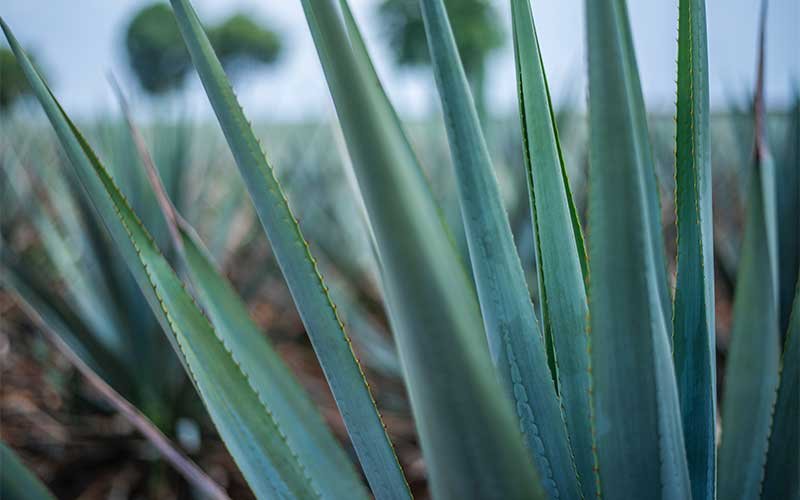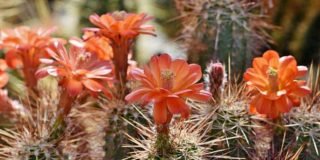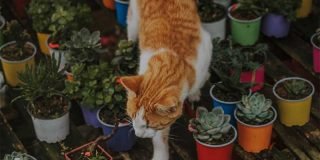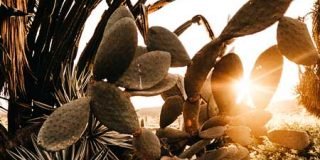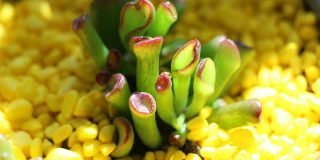Contents
If you want to find out more information about agave, make sure to check out the list below for the best agave plants to grow in your garden. We will also provide some tips that can help you be successful in growing agave plants whether indoors or outdoors.
Agave varieties prefer full sun exposure and they do best in sandy, well-draining soil. Agave is the perfect plant for forgetful gardeners that tend to forget to water their plants from time to time since they can live even with a small amount of water. Some varieties are cold-tolerant while others cannot tolerate cold climates. Agave plants bloom flowers although it is a rare occurrence, they produce a large flower spike that resembles asparagus.

Here is a list of the best agave plants to grow in the garden:
1. Agave attenuata – This succulent is a spineless variety of agave, which makes it a safe option. It is also known as the Foxtail or Dragon-Tree Agave. It can grow up to 4-5 feet tall. Its flowers are greenish-yellow on the spike. This plant can be used as a houseplant as it does not have spines which can be quite dangerous, unlike the other varieties mentioned on this list. You can plant the Foxtail Agave in a small yard or as a poolside plant where it is not at risk of being brushed up on accidentally by pets, guests, or family members alike.
2. Agave americana – This plant is commonly known as the American Century Plant. Its leaves are bluish and have saw-tooth spines. You can use this plant as a specimen plant in the garden as it can grow quite large with the appropriate growing conditions. Agave Americana Marginata is a known variegated variety of Agave americana.

3. Agave filifera – This plant is also known as the Thread Agave. Its leaves have white edges and have thread-like filaments, hence the name, Thread Agave. This plant has dark green leaves with a slight bronze shade. If you prefer a medium-sized plant, you can choose the Thread Agave; it can grow up to 2 feet tall and 3 feet wide.
4. Agave victoria-reginae – It is also known as Queen Victoria Agave. It is a smaller plant, making it perfect for pots or containers as it only grows about a foot up to 18 inches in height. Its leaves have black tips and it is curved inward which creates a compact dome. This plant can live up to 20 to 30 years and can produce lovely cream or reddish-purple flowers on a fifteen-foot stalk.
5. Agave parviflora – It is also known as the Small Flower Agave, Small Flower Century Plant, or Santa Cruz Striped agave. This plant is a small variety of agave; it can grow up to 6-8 inches tall. It is also similar to the Agave filifera because its leaves have white graphic markings with beautiful hair filaments. This plant produces a flower stalk after 6-8 years that can reach up to 3-7 feet high and blooms cream or yellow flowers that are quite attractive to bees, butterflies, and other pollinators.

6. Agave bracteosa – It is also known as Squid Agave or Candalebrum Agave. It is a drought-tolerant, slow-growing agave plant. It can be used as a potted specimen and be added to your rock garden.
7. Agave vilmoriniana – It is also known as Octopus Agave. It has untoothed arching and twisting leaves. Its rosettes can grow up to 3-4 feet tall and 5-6 feet in width. This plant is considered as one of the friendlier Agave varieties because it has soft serrations on the margins of the leaf and it has a soft terminal spine.
8. Agave tequilana azul – It is also known as Weber’s Blue Agave, Tequila Agave, or Blue Agave. It is commonly used to make tequila in Jalisco, Mexico. It is a beautiful garden plant and it can grow up to 6 feet tall and blooms in 6 to 8 years with a 15 feet spike with yellow flowers.
This plant can be used in landscapes for areas found in high altitudes. The Blue Agave prefers rich, well-draining sandy soil. It can grow quite huge and can live up to several decades, so you must grow it if you are ready for a long-term commitment.
9. Agave parryi – It is also known as the Artichoke Agave. It is a lovely plant and it has sharp black spears tip on the end of its wide bluish gray-green leaves. It can grow even in rocky and dry slopes. This plant loves full sunlight and can be planted in pots or containers.
10. Agave desmettiana – It is also known as the Smooth Agave. If you prefer people and pet-friendly agave, this one is perfect for you. It can be used as a focal plant in xeriscapes or desert gardens.
You can also plant the Smooth Agave near patios, whether as a single specimen plant or placed in groups. This succulent produces its pups from basal offshoots, making it easy to propagate; you can easily repot the pups in new containers.
11. Agave lophantha – It is also known as a Quadricolor Agave. This plant has dark green leaves with yellow stripes, pale green midstripe with reddish edges lining the teeth. It grows slowly and takes a long time to grow in their containers.
12. Agave macroacantha – It is also known as the Large-thorned Agave or Black-Spined Agave. This plant has medium-sized rosettes and blue-gray narrow leaves. It has sharp 1-inch black terminal spines on the tips. It produces offsets and blooms tiny purplish-green flowers and prefers full sun exposure.
13. Agave geminiflora – It is also known as Twin Flower Agave and Agave Palito. This plant has hundreds of leaves that form a well-rounded compact rosette that grows up to 3 feet tall. It takes up to 10 to 15 years for the plants to mature. It produces a beautiful flower spike that grows up to 8 to
12 feet tall. Its flowers grow in pairs hence the name Twin Flower Agave. This variety of agave is monocarpic, it dies after it blooms flowers. Plants grown indoors do not bloom flowers.
14. Agave potatorum – It is also known as Butterfly Agave. This succulent’s leaves resemble a butterflies’ wings. It is a medium-sized agave that grows slowly so you can plant it in pots or containers. If grown in a container, the butterfly agave is easy to control.

15. Agave angustifolia – It is also known as Caribbean Agave. This plant has narrow leaves and forms a rosette; it is a variegated Century Plant and grows up to 4 feet tall and wide. It has pale green leaves with cream-colored margins.
It is stiff and has dangerous, sharp spines on the tips. Be careful when growing this succulent as it is quite painful when the spines prick your skin. Its flower stalk produces small plantlets that can be replanted. It is quite fragrant and tends to attract butterflies, bees, and other pollinators.
16. Agave bovicornuta – It is also known as Cowhorn Agave. This plant has glossy leaves that widens and resembles a spatula with spiny red tips. The Cowhorn Agave grows up to 3 feet in height and 4 feet in width.
17. Agave salmiana – It is also known as Ferocious Agave. It has well-armed spines on the edges of its leaves and a stout stinger on the tips. It grows up to 4 feet in height and 3 feet in width. It can withstand cool weather but must remain dry during the wintertime.
Information about Agave Plants
Leaves – Agave plants do not have stems; they have strappy leaves that usually have sharp spines on their tips. Foliage tends to be blue-green in hardy varieties, and gray-green in warm climate varieties. Some varieties are variegated and have gold, white, or cream markings.

Flowers – When the agave plants become mature, they produce a tall, flower-stalk that grows from the center of the plant. The flowers are like bells and last long, usually in shades of yellow, green, or white. Agave plants are monocarpic when they bloom flowers, they die. No need to worry though, as it produces plenty of offsets or pups that can take the place of the parent plant.
Which Areas Do Agave Succulents Grow Well?
Some agave plants are not frost-hardy, but the Agave parryi can be planted as a perennial plant in areas that belong to the USDA Zone 5. The majority of the agave plants are hardy in USDA Zones 8-9 and up.
Sunlight exposure – Agave plants need an area with full sun to partial shade, if you live in an area with hotter climates, the agave plant will be able to handle more shade.
Soil – Agave succulents need well-draining soil, but they grow best in rocky or sandy soil.
Water – Mature agave plants are very drought-tolerant, during the first month you must water your plant every 4 or 5 days while the plant is still not established. Then you can do it once a week, then gradually spacing the watering of the plant to every other week, depending on the weather conditions in your area.
Feeding or Fertilizer – Do not feed your agave plants, they can take care of themselves. Feeding can cause early flowering, if this occurs, the agave plants die off because most of them are monocarpic. When the parent plant dies, the offsets or pups can take the place of the parent plant.

How to Grow Agave Plants From Seeds
You can grow agave succulents from seeds, follow the instructions below so you can be successful in growing agave plants from seeds.
Prepare the items that you will need:
- Shallow planting containers
- Drip trays
- Seeds
- Sterilized seed starting mix
- Plastic wrap or bags
2. Use a commercially prepared sterilized seed starting mix or you can prepare one using a mixture of sharp sand, pumice or perlite and vermiculite, coco coir or sphagnum moss. Sterilize the mix and bake it at 350 degrees Fahrenheit for 30 minutes.
3. Fill the clean planting containers with the sterilized seed starting mix.
4. Scatter the seeds on the surface of the mix, you can leave them exposed or you can sprinkle some mix over them to anchor them in place. Do not cover the seeds deeply as the agave seeds need sunlight to germinate.
5. Fill the drip trays with warm, distilled, or sterilized water and set the planting container in the water. When the top part of the soil is moist, remove the containers from the drip tray and allow them to drain.
To sterilize water, allow the water to sit for 24 hours, this allows the chemicals to dissipate. Bring the water to a full boil and boil it for 5 minutes. Let the water cool completely and pour it on a clean container from a height of 3 feet to aerate the water well.
6. After draining the excess water from the plant containers, cover them with plastic bags or plastic wrap. This allows sealing of the moisture inside and keeps it consistent during the germination process.
7. The agave seeds must be kept in a warm area (65-70 degrees Fahrenheit) and it must be exposed to bright, indirect sunlight. Germination may take a while, so you must be patient during this process. The young sprouts can be seen within 14-21 days of planting the seeds. After the seedlings appear, you must remove the plastic bag or plastic wrap.
8. Water the seedling sparingly, maybe at least 2x a week. You need to keep the soil slightly moist; too much water can kill your seedlings. You can use a spray bottle when watering your seedlings so you can prevent the displacement of the seeds and seedlings.
9. When the agave seedlings have 2-3 leaves, you can transfer them in their pots or containers. Just make sure to use pots that have drainage holes.

How to Propagate Agave Plants
Agave may take a long time to grow when planted using seeds, most of the time gardeners use agave pups or offsets. If you can buy agave pups from your local garden center or if you know a fellow succulent grower, you can ask for small pups that you can grow in containers or pots. Separate the pups from the parent plant using a sharp knife or trowel. Sometimes you can twist them off by hand by only using little exertion. Be careful when removing pups from spiny agave plants.
When removing pups from the parent plant, it is best that it has long roots but it is not necessary. If you can get a pup with no roots, you can still go and plant it and it will still grow just fine.
Agave plants generate pups on their stems or send them a few meters away. You can easily gather and repot them in a well-draining container. You must keep the young plants watered, but do not overdo it as too much water can cause root rot. Agave plants tolerate neglect; they can grow fast and spread fast even when left unattended in the garden.

How to Grow Agave Plants in Containers or Pots
Agaves just like the other succulents have shallow roots. They can be grown in different container sizes because they do not need too much soil. You must use a well-draining soil and the container must have drainage holes. You can use terracotta containers as they allow draining of excess water when you water your agaves. You can create your soil mix by mixing two to three parts potting mix with 1 part gravel.
Container grown agave plants can be repotted every couple of years using new soil. Agave plants can produce sucker roots; if the pot is overcrowded with roots you can cut the roots. You must allow the plant a week or so to readjust after cutting the roots, then you can water it again so it won’t overwhelm them.
Water your agave plants every week during summertime and once a month during wintertime. Make sure to water the plant when the soil is completely dry. If you live in areas that have extremely dry conditions, your agave plant may need more watering but no need to worry as agave succulents are very forgiving and they can thrive in extreme drought conditions.
Garden Design Tips for Agave
- Agave plants can be used as a sculptural focal point or a focal plant in an outdoor garden. Just make sure to allow plenty of walking space around it so no one will get injuries caused by the spines of the plant.
- Agave succulents can be used as a border grouping; you can plant several of the same plants or a combination of different varieties.
- Agave plants are textural and structural and can be used as an ornamental plant. Agave succulents can bring a vivid contrast with other plants in your garden. You can pair them with ornamental grasses for a contrasting effect, soft grass versus the hard and spiny edges of agaves.

How to Prune Agave Plants
Agave plants can be pruned and this can be done by removing dead leaves and removing any areas that have diseases. You can do some seasonal pruning before and after the growing season. After the winter months, you can remove any dead or damaged spears to allow some room for new growth.
You can keep your plants indoors as a houseplant during winter, use grow lights so it can grow well even when indoors. You can cut it down to size if there are spears that can be dangerous, and you must cut or remove them.
Agave plants can have sudden bursts of growth so you have to cut it back so you can control its excessive growth. Do not cut portions off the spears as the plant can look ugly with an exposed scar. Do not overdo the trimming of the plant; it can affect the ability of the plant to store water.
When pruning your agave plants use tools that are sharp and sturdy. Agave succulents have strong leaves and cutting them can be quite difficult to do. Protect yourself from spines and exposure to the agave sap.
- Use proper protection
- Use durable gloves
- Wear pants and long sleeves

Pest and Diseases of Agave Plants
Agave plants encounter a few problems, one of them is the agave snout weevil, and it burrows into the plant’s center to lay its eggs which causes the plant to collapse. You will not be able to notice it so you can prevent this problem. If it occurs to one of your plants, you must remove it immediately and check for any remaining grubs.
Are you wondering which is the best agave plants that you can grow in your garden? You came to the right place. Eden Succulents is all about succulents. We love growing and caring for them and our passion for them inspires us to continuously learn about succulents and share all our knowledge with our fellow gardeners. If you are searching for guides and other information about succulents, make sure to check out our website. If you have any questions, suggestions, comments, or inquiries, please let us know. We will do our best to help you out!
Agave Filifera Schidigera
- PACKAGE OF 50 SEEDS.
- Brand New and High Quality Seeds

